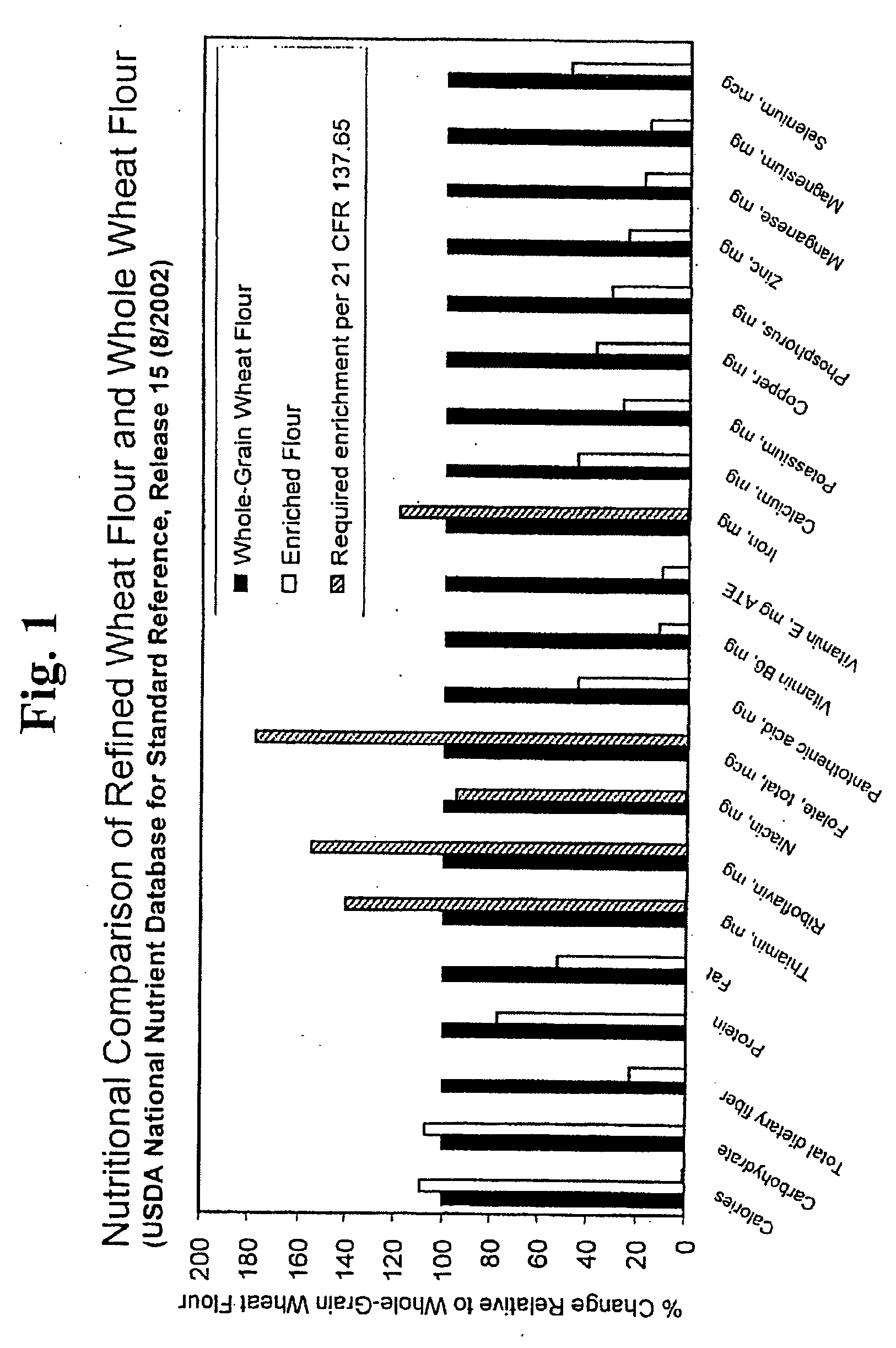Process for producing an ultrafine-milled whole-grain wheat flour and products thereof
a technology of ultrafine milling and which is applied in the field of production of ultrafine milled whole grain wheat flour and the products, can solve the problems of not having the nutritional value of affecting the quality of products made with traditional whole grain wheat flour, so as to achieve the effect of increasing nutritional value and fiber conten
- Summary
- Abstract
- Description
- Claims
- Application Information
AI Technical Summary
Benefits of technology
Problems solved by technology
Method used
Image
Examples
example 1
[0072] A quantity of Platte hard white winter wheat was obtained and milled according to known milling procedures. The fine fraction and the coarse fraction are separated during the milling process. The fine fraction has a particle size of 1.4% coarser than a US 100 Wire (mesh size 149 μm), FIG. 7 (ref. 1270). Therefore, 98.6% of the fine fraction has a particle size distribution of less than or equal to 150 μm. Further sifting was done using a U.S. 200 Wire (74 μm), a U.S. 325 Wire (44 μm) and a U.S. 400 Wire (37 μm). Forty-seven percent of the fine fraction was left on the U.S. 200 Wire, indicating that 53% of the fine fraction has a particle size distribution of less than or equal to 74 μm. About 77% of the fine fraction was left on a U.S. 325 Wire, indicating that 23% of the fine fraction had a particle size distribution of less than or equal to 44 μm. Finally, 98% of the fine fraction was left on a U.S. 400 Wire, indicating that 2% of the fine fraction had a particle size of le...
example 2
High Capacity Installation to Produce Ultrafine-Milled Whole-Grain Wheat Flour:
[0076] A typical flour mill flowsheet produces refined wheat flour (the fine fraction) and the coarse fraction. The coarse fraction will be conveyed continuously from the flour mill to two gap mills, FIG. 6. A first gap mill passage will use two machines with an estimated throughput of 110 cwt / hr (11000 hundred weight per hour). The flowsheet, FIG. 6, will reduce 100 cwt / hr of coarse fraction to the desired particle size. The ground coarse fraction will be conveyed from the gap mill by means of a 5000 cfm negative pressure pneumatic lift to a filter, designed to separate the air from the conveyed product without the use of a cyclone. The ground coarse fraction will exit the filter and be discharged into a Vibro Sifter. The Vibro Sifter will separate the ground coarse fraction by using centrifugal and vibratory force to sift the ground coarse fraction. The material passing through the Vibro Sifter screen...
example 3
High Capacity Installation to Produce an Ultrafine-Milled Coarse Fraction:
[0077] The same procedure as disclosed in Example 1 will be followed, except the ultrafine-milled coarse fraction is the end product and will not be mixed with the fine fraction. The ultrafine-milled coarse fraction is higher in protein, fiber and other nutrients than either refined wheat flour or whole wheat flour, FIG. 5 while having a texture similar to refined wheat flour.
PUM
 Login to View More
Login to View More Abstract
Description
Claims
Application Information
 Login to View More
Login to View More - R&D
- Intellectual Property
- Life Sciences
- Materials
- Tech Scout
- Unparalleled Data Quality
- Higher Quality Content
- 60% Fewer Hallucinations
Browse by: Latest US Patents, China's latest patents, Technical Efficacy Thesaurus, Application Domain, Technology Topic, Popular Technical Reports.
© 2025 PatSnap. All rights reserved.Legal|Privacy policy|Modern Slavery Act Transparency Statement|Sitemap|About US| Contact US: help@patsnap.com



